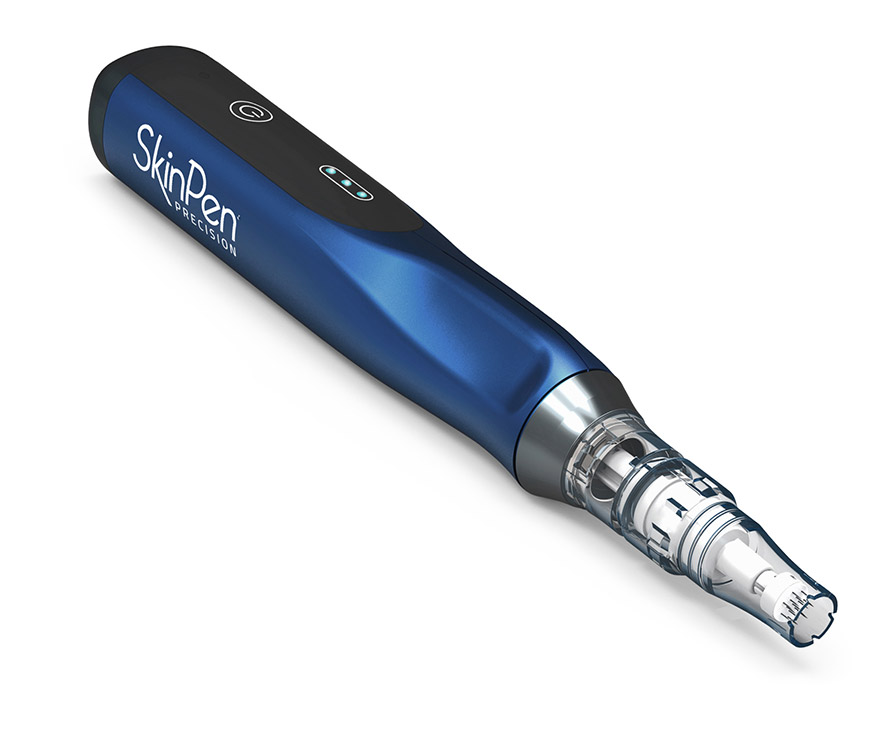Precision Engineering

Mechanical microneedling is the process of using tiny needles to create thousands of “micro” channels in the skin, to stimulate the wound healing response mechanism and collagen remodelling process. Though it’s been safely used by medical professionals for a wide variety of skin conditions since the 1990s, mechanical microneedling has suffered from little oversight in the industry and was in urgent need of redesign for the correct classification and for patient safety against cross- contamination.
In March 2018, after three years of proactive work with the FDA designed to clean up the microneedling arena, Bellus Medical (Dallas, Texas), earned the first and, so far, only FDA clearance of a microneedling pen with its flagship product, SkinPen Precision. The clearance established a new microneedling classification and category, making SkinPen the only legally marketed Class 2 microneedling pen in the USA and setting a new standard.

Improvements patients can expect to see
Collagen Induction Therapy (CIT) triggers the wound healing response – sensory nerve endings are stimulated, cell membranes damaged, and mast cells stimulated that all lead to the release of neurotransmitters, a complex signalling process made up of growth factors and cytokines. This instigates the proliferation of platelet, fibroblast, epithelial and endothelial cells and the natural healing response, leading to the repair and regeneration of new healthy tissue. This wound healing response will not only encourage epidermal repair, but also dermal regeneration, to induce the endogenous production of cutaneous collagen and fortification of the epidermal tissue as well as increased integrity and density of the dermal matrix.
Patients will receive between three to six procedures one month apart, dependent on the treatment protocol, age and condition of the skin. Regular top up treatments would be recommended once every three months to maintain maximum effects.

Sally Wagstaff from the Xodos Clinic in Sutton Coldfield says, “I decided I wanted to take on needling at the clinic as I wasn’t providing a treatment that adequately treated acne scarring and stretch marks. I did quite a lot of research into pens (I knew I didn’t want a roller), and it became very apparent that SkinPen was [the best] option due to its safety. We started using it...and wow! While we have been really pleased with the scar reduction, we just can’t get over the quality of its anti-ageing results, it’s quite unbelievable. I recommend it to a far larger proportion of my clients than I was expecting to be able to and they all love it. It’s going to be a huge part of our business in 2019.”
To find out more about the SkinPen Precision visit BioActive Aesthetics at stand B10 at Aesthetic Medicine Live on 23-24 March 2019 at Olympia London
Click here to register for your FREE visitor ticket.
Mechanical microneedling is the process of using tiny needles to create thousands of “micro” channels in the skin, to stimulate the wound healing response mechanism and collagen remodelling process. Though it’s been safely used by medical professionals for a wide variety of skin conditions since the 1990s, mechanical microneedling has suffered from little oversight in the industry and was in urgent need of redesign for the correct classification and for patient safety against cross- contamination.
In March 2018, after three years of proactive work with the FDA designed to clean up the microneedling arena, Bellus Medical (Dallas, Texas), earned the first and, so far, only FDA clearance of a microneedling pen with its flagship product, SkinPen Precision. The clearance established a new microneedling classification and category, making SkinPen the only legally marketed Class 2 microneedling pen in the USA and setting a new standard.

Improvements patients can expect to see
Collagen Induction Therapy (CIT) triggers the wound healing response – sensory nerve endings are stimulated, cell membranes damaged, and mast cells stimulated that all lead to the release of neurotransmitters, a complex signalling process made up of growth factors and cytokines. This instigates the proliferation of platelet, fibroblast, epithelial and endothelial cells and the natural healing response, leading to the repair and regeneration of new healthy tissue. This wound healing response will not only encourage epidermal repair, but also dermal regeneration, to induce the endogenous production of cutaneous collagen and fortification of the epidermal tissue as well as increased integrity and density of the dermal matrix.
Patients will receive between three to six procedures one month apart, dependent on the treatment protocol, age and condition of the skin. Regular top up treatments would be recommended once every three months to maintain maximum effects.

Sally Wagstaff from the Xodos Clinic in Sutton Coldfield says, “I decided I wanted to take on needling at the clinic as I wasn’t providing a treatment that adequately treated acne scarring and stretch marks. I did quite a lot of research into pens (I knew I didn’t want a roller), and it became very apparent that SkinPen was [the best] option due to its safety. We started using it...and wow! While we have been really pleased with the scar reduction, we just can’t get over the quality of its anti-ageing results, it’s quite unbelievable. I recommend it to a far larger proportion of my clients than I was expecting to be able to and they all love it. It’s going to be a huge part of our business in 2019.”
To find out more about the SkinPen Precision visit BioActive Aesthetics at stand B10 at Aesthetic Medicine Live on 23-24 March 2019 at Olympia London
Click here to register for your FREE visitor ticket.
